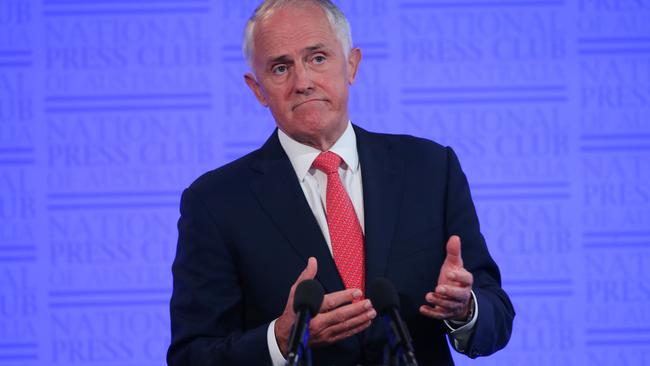Malcolm Turnbull backs new coal-fired power stations to stop SA’s power woes spreading
UPDATED: The State Government has condemned Prime Minister Malcolm Turnbull’s push to subsidise clean coal as “a fairytale”, branding the move as unfeasibly expensive.
SA News
Don't miss out on the headlines from SA News. Followed categories will be added to My News.
- PM Turnbull confirms $1.75m donation to own party
- ‘Multiple faults’ led to huge South Australian blackout
- Report shows wind farm failure was worse than previously thought
- $200m solar plant near Tailem Bend to power 40,000 homes
READ BELOW: Simple solution to all our energy problems
THE State Government has condemned Prime Minister Malcolm Turnbull’s push to subsidise clean coal as “a fairytale”, branding the move as unfeasibly expensive.
State Energy Minister Tom Koutsantonis said no countries or businesses were going to invest in a new coal-fired power station.
“If clean coal technology was viable then it would already be operating in the market - the fact is that it is not,” Mr Koutsantonis said.
“If you were to implement the technology needed to make the burning of coal as efficient as wind, solar or gas, the cost of that coal-fired generation would be well in excess of a new windfarm, a new solar farm, battery technology, pumped hydro, renewable energy or gas.”
Mr Turnbull yesterday outlined a vision to use low-emission coal power plants to help secure Australia’s energy supply.
Mr Koutsantonis also took aim at State Liberal Leader Steven Marshall, saying Federal Energy Minister Josh Frydenberg had issued his strongest objection yet to his 10-year moratorium on unconventional gas fracturing in the state’s South-East.
“In a very clear, concise way, Mr Frydenberg said these words: more gas equals more jobs,” he said.
“Well that means less gas means less jobs. That means Mr Marshall’s policy will hurt South Australian jobs and the South Australian economy.”
Mr Turnbull backed the new coal-fired power plants as he declared that he was in politics to get results, not to be a “political hack’’.
He said new, low-emission coal power plants could be part of the mix of technologies needed to prevent South Australia’s energy woes from spreading to the rest of the nation.
Australia was the world’s largest coal exporter but was yet to follow other nations in building modern coal-fired power stations, he said.
“There are new, coal-fired power stations being built around the world, many of them of that very advanced type that have much lower emissions, because they operate at much higher temperatures,” Mr Turnbull told the National Press Club.

“And many of them would have emissions levels that are half — if not less — than the emissions from some of our oldest power stations. So, yes, the answer is, coal will have a role to play for many decades into the future.”
Mr Turnbull said there was too much ideology in the debate about Australia’s energy future. “My interest is in results. I am not a political hack,’’ he said.
Labor climate change and energy spokesman Mark Butler said he doubted new coal-fired plants would be built.
“Malcolm Turnbull can talk about ‘new’ coal all he likes but the best advice we have is that new, coal-fired power stations are simply too expensive, don’t provide the flexibility that’s needed to complement renewables and, even with the latest technology, are too dirty to get us where we need to be by mid-century in terms of pollution cuts,’’ Mr Butler said.
In order to boost the stability of the national energy grid, the Federal Government will invest $20 million in demonstration projects that store electricity for later use.
Energy Minister Josh Frydenberg will visit Adelaide today and be briefed on AGL’s virtual power plant, now in the first stages.
It will eventually involve 1000 digital, connected batteries installed at homes and small business across the city with an output equivalent to a 5MW solar generator.
The Prime Minister yesterday also said he was confident US President Donald Trump would honour his commitment to accept refugees currently held in Australian detention centres on Nauru and Manus Island.
Mr Turnbull said the refugees would be the subject of “vigorous” security vetting before being allowed into the US.
Simple solution to all our energy problems
By Tory Shepherd
SOUTH Australia could generate more electricity than it needs and start exporting energy using pumped hydro technology, a top expert says.
Professor Andrew Blakers from ANU is looking at how the technology can smooth over any short-term glitches in supply from solar and wind energy. Pumped hydro uses large hills for elevation.
Water is pumped up to a small “turkey nest” reservoir while energy is cheap and released when it’s more expensive.
The falling water drives a turbine. Australia’s Chief Scientist Alan Finkel talked up the technology this week in Adelaide, saying the vast majority of energy was already stored this way but had been overlooked in Australia.
Prime Minister Malcolm Turnbull said yesterday he had written to Dr Finkel about it. Prof Blakers said it was “better than everything” else, can reach full power within 90 seconds, and can take care of the sort of intermittency in the system that renewables can cause. There are dozens of possible sites in SA, he said, with differentials up to 600m.
He said it was a “realistic” option that SA could get up to 100 per cent renewables with such a storage system, and possibly more.


